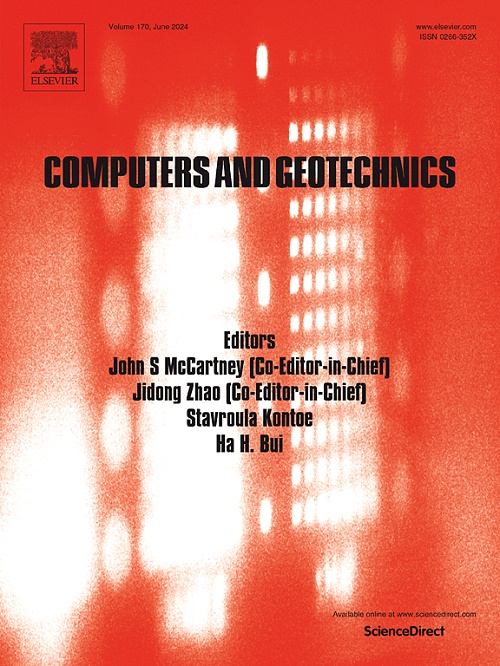考虑速率和动力效应的不排水粘土中球腔动态膨胀的半解析弹粘塑性解
IF 5.3
1区 工程技术
Q1 COMPUTER SCIENCE, INTERDISCIPLINARY APPLICATIONS
引用次数: 0
摘要
在振动打桩、动力锚杆安装、动力贯入试验等工程应用中,动力空腔扩张现象普遍存在。动力阻力包括弹塑性、粘性(或速率效应)和由周围土壤加速引起的惯性所引起的动力效应。现有的土体空腔膨胀解主要集中在弹塑性阻力上,很少考虑速率效应或动力效应。到目前为止,仍然缺乏能够同时考虑这三种影响的动态渗透阻力模拟方法。本研究提出了一种集弹塑性、粘度(或速率效应)和动态效应于一体的半解析模型。通过将弹粘塑性本构模型(应变率相关)纳入球腔膨胀理论的总体框架,并结合动态应力平衡方程来模拟动态效应,实现了这种集成。通过与已发表的修正Cam-Clay (MCC)模型的准静态和动态解的简并形式进行比较,验证了所提出的球腔动态扩展半解析解的有效性。进行了全面的数值参数研究,量化和分析了速率效应和动力效应的贡献。结果显示了三种不同的速度范围:低、中、高速。低速范围内((Vc/a <;1)应变率效应迅速增强,而动力效应仍然可以忽略不计。在中速范围内(1 <;Vc / & lt;25)时,极限空腔压力主要由弹塑性变形和应变率效应组成,动态效应开始发挥作用。在高速范围内(Vc/a >;25)时,动力效应的贡献变得更加占主导地位,在膨胀率为100时可能超过20%。在空间分布上,动态效应对周围土体的影响范围大于应变率效应。本文章由计算机程序翻译,如有差异,请以英文原文为准。
Semi-analytical elastic-viscoplastic solution for dynamic spherical cavity expansion in undrained clay considering rate and dynamic effects
The phenomenon of dynamic cavity expansion is ubiquitous in engineering applications such as vibratory pile driving, dynamically installed anchors, and dynamic penetration tests. Dynamic resistance encompasses contributions from elastoplasticity, viscosity (or rate effect), and dynamic effects due to the inertia induced by accelerating surrounding soil. Existing solutions for cavity expansion in clay predominantly focuses on resistance from elastoplasticity, with a few paid to additionally consider either rate or dynamic effect. To date, there is still a lack of solution that can simulate dynamic penetration resistance into clay considering all the three effects. This study presents a semi-analytical model that integrates elastoplasticity, viscosity (or rate effect) and dynamic effects. This integration is achieved by incorporating an elastic-viscoplastic constitutive model (strain rate-dependent) into the general framework of spherical cavity expansion theory, coupled with the dynamic stress equilibrium equation to simulate dynamic effects. The proposed semi-analytical solution for dynamic spherical cavity expansion is validated by comparing its degenerate form with published quasi-static and dynamic solutions for the modified Cam-Clay (MCC) model. A comprehensive numerical parametric study is conducted to quantify and analyze the contributions of rate and dynamic effects. The results reveal three distinct velocity ranges: low, medium, and high-velocity. In the low-velocity range ((Vc/a < 1), the strain rate effect rapidly intensifies, while the dynamic effect remains negligible. In the medium-velocity range (1 < Vc/a < 25), the limit cavity pressure primarily comprises elastic–plastic deformation and strain rate effects, with the dynamic effect starts to play a role. In the high-velocity range (Vc/a > 25), the dynamic effect’s contribution becomes much more dominating, potentially exceeding 20 % at an expansion rate of 100. Regarding spatial distribution, the dynamic effect influences broader ranges of the surrounding soil than the strain rate effect.
求助全文
通过发布文献求助,成功后即可免费获取论文全文。
去求助
来源期刊

Computers and Geotechnics
地学-地球科学综合
CiteScore
9.10
自引率
15.10%
发文量
438
审稿时长
45 days
期刊介绍:
The use of computers is firmly established in geotechnical engineering and continues to grow rapidly in both engineering practice and academe. The development of advanced numerical techniques and constitutive modeling, in conjunction with rapid developments in computer hardware, enables problems to be tackled that were unthinkable even a few years ago. Computers and Geotechnics provides an up-to-date reference for engineers and researchers engaged in computer aided analysis and research in geotechnical engineering. The journal is intended for an expeditious dissemination of advanced computer applications across a broad range of geotechnical topics. Contributions on advances in numerical algorithms, computer implementation of new constitutive models and probabilistic methods are especially encouraged.
 求助内容:
求助内容: 应助结果提醒方式:
应助结果提醒方式:


